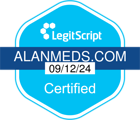Discover
Get Started
Get Started
Discover
Get Started
Treatments
Discover
Get Started
Treatments
Alan Health Technologies, Inc.™ (doing business as Alan Meds™ and Alan Health™) operates a patient management platform in collaboration with independently owned and operated physician networks, including MDI Medical Group, P.C., and Beluga Health, P.A. Medical services are facilitated through Alan Health™ infrastructure but are provided exclusively by licensed, independent healthcare professionals. Alan Health™ does not itself provide medical or pharmacy services. Payment for services does not guarantee that a prescription will be issued or that medication will be dispensed. Medication appearance, formulation, and packaging may differ from the images displayed on this website.
Prescriptions for any medications require a consultation with a licensed healthcare provider, who will evaluate the patient’s medical condition and determine clinical appropriateness. Additional eligibility criteria may apply. For complete terms and important safety information, please refer to the disclosures provided on our website.
The compounded medications offered through Alan Health™ have not been reviewed or approved by the U.S. Food and Drug Administration (FDA). These products have not been evaluated by the FDA for safety, efficacy, or manufacturing quality and are not considered FDA-approved. The manufacturing processes for these compounded products have also not been reviewed by the FDA.
Ozempic® (semaglutide), Wegovy® (semaglutide), Mounjaro® (tirzepatide), Zepbound® (tirzepatide), Saxenda® (liraglutide), Victoza® (liraglutide), and generic liraglutide are not compounded products and are not manufactured or supplied by Alan Health Technologies, Inc.™ Ozempic®, Wegovy®, Saxenda®, and Victoza® are registered trademarks of Novo Nordisk™. Mounjaro® and Zepbound® are registered trademarks of Eli Lilly and Company™. These medications are FDA-approved. Alan Health™ is not affiliated with, endorsed by, or sponsored by Novo Nordisk™, Eli Lilly and Company™, or any of their respective affiliates or products.










































